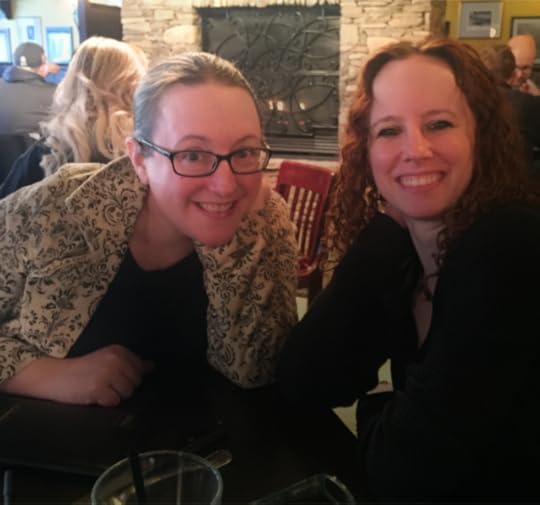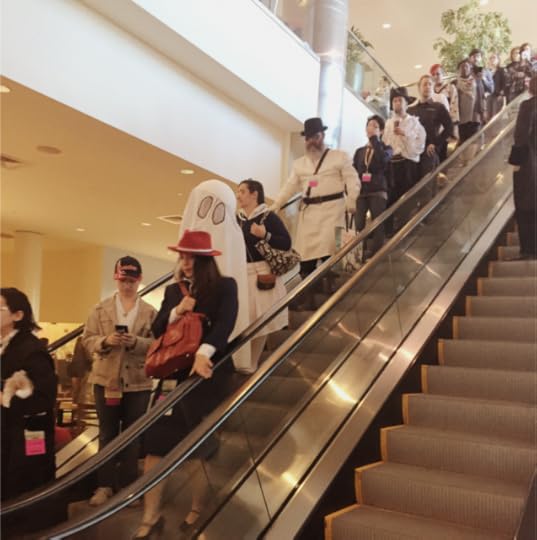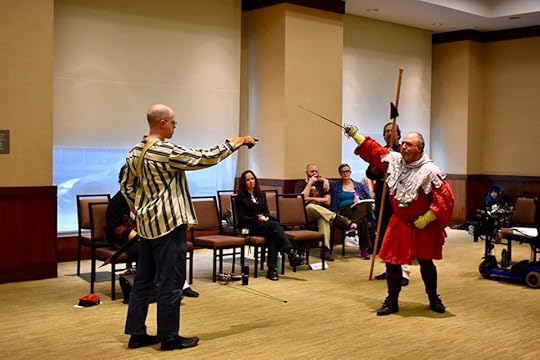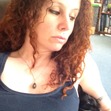Genevieve Iseult Eldredge's Blog, page 19
February 4, 2017
Presales for Circuit Fae: Moribund + an Extra Inside Look!
Hello, my pretties and all you sleeper-princesses out there! At long last, presales are up for Circuit Fae: Moribund. Get your copy and be the first to read on September 12, 2017.
As a special treat for clicking on this link, I’ll show you my “character sheet” for Syl Skye, the Heroine of Circuit Fae. The character sheets are a little exercise Christina had me do as part of my prep work for the series.
Here are your links!
And now, the character sheet!
SYL SKYE
Quote:
“I run like a girl, which…as it turns out, is pretty darn fast.”
Role in Story:
Primary heroine
Occupation:
High school student/sleeper princess of the fair Fae
Physical Description:
5.4, of Irish descent, bright red hair and grey eyes. A genuine smile touched by mischief. Dresses Goth chic with fishnets and Doc Martens.
Story Line Summary:
A sleeper princess? Wait, what? I’m not ready to be royalty or anything. I just wanted a little popularity. You know, maybe to have someone to sit with at lunch or get the lead in the school play or, you know, date the head cheerleader… Normal stuff.
Character Arc – from an emotional POV, where is this character at the start of the book?
Syl is stuck in a rut. She doesn’t belong, even among the geeks and nerds. She knows she’s different, but her life seems to be nothing more than waiting for something—anything—to happen
Similar Characters:
Merida from OUAT
Babydoll from Sucker Punch
Character Strengths: List three great things about your character
She’s calm and witty, even in the face of danger
She’s merciful
She sees the best in people
Character Weaknesses: List three negatives about your character.
She’s naïve.
She’s stubborn
She’s too eager for adventure
Love Interest Alignment:
Syl is a demisexual lesbian. She’s had some school-girl crushes, but she’s never experienced romance or love before meeting Rouen. (Click here for more on demisexuals)
Love Interest Benefit: How is this person better when they are with their love interest?
With Rouen, Syl learns to be bold and brave and to trust in herself and her powers as a sleeper-princess.
Describe Chara’s Favorite Room:
Our apartment is super-small, but last year, Mom let me knock out the shelves on one wall and make a tiny reading nook. It’s more like a glorified cupboard, but I’ve hung my thousand-cranes mobile (really, it’s more like 63 cranes), and I use Glamma’s old rocking chair cushion to sit on. It’s not much, but it’s cozy and it’s mine. I spend a lot of rainy afternoons there, curled up with my e-reader and a cup of tea.
As always, thank you for reading!
~GIE
If you enjoyed this post, please share!
Never miss a blog post. Sign up here!
Or right here at Monster House Books!
The post Presales for Circuit Fae: Moribund + an Extra Inside Look! appeared first on Monster House Books.
February 1, 2017
Frozen: Happily Ever After…Without a Boy
It’s no secret that Frozen has a lot of lesbian fans. With two independent female protagonists, not to mention the subtext of “Let it Go” as a possible coming out ballad, the movie’s popularity among LGBTQ fans can’t be denied. But why? There’s a wealth of opinions on the topic—theories that range anywhere from Elsa and Anna not being biological sisters to analyses of how growing up apart influenced their development.
But regardless of your favorite theory or ship, the one thing most Frozen fans agree on is that it’s the relationship between the two sisters that drives the movie. These very real and realistic feelings between women is at the heart of Frozen’s massive popularity.
Because, quite simply, it’s not been done to this degree in a mainstream movie—especially a Disney movie.
It’s no secret that in a lot of movies, female characters are not given equal time or treatment. Too often, women in movies are love interests, there to bolster the male ego, or worse, to be a trophy for the male protagonist once he wins the day.
Even more telling is that when two women appear in a movie, it’s often just to talk about the male protag or (ugh) to fight over him. Women are trophies, rivals, bitches, mean girls, love interests—all to glorify the male presence in the movie. Realistic relationships between women are rarely explored.
In fact, comic strip creator Allison Bechdel created the Bechdel Test in 1985 to prove that Hollywood movies were portraying female characters in a stereotypical, unrealistic way. Basically, in a nutshell, to pass the Bechdel Test, the movie must answer “Yes” to the following:
Are there more than two named female characters?
Do those two named characters have a conversation at any point?
Is that conversation about literally anything other than a man?
You might be surprised about the number of movies that fail this test. Harry Potter and the Deathly Hallows II, the original Star Wars trilogy, Avatar, the entire Lord of the Rings Trilogy, just for starters (see links below). It’s no wonder why this portrayal leaves a lot of women cold, regardless of where we fall on the sexual-preference spectrum.
But what about Disney movies? Well, there are, as it turns out, a list of Disney films that do pass the Bechdel Test: Alice in Wonderland, Cinderella, 101 Dalmations, The Rescuers, Sleeping Beauty, Snow White & the Seven Dwarves, Brave, Lilo & Stitch, The AristoCats, Mulan, and Peter Pan to name a few.
However, as one adroit blogger points out, those that pass have Heroine/Villainess interactions or Mother/Daughter interactions:
Heroine/Villainess
Alice in Wonderland (Queen of Hearts/Alice)
Cinderella (Stepmother and stepsisters/Cinderella)
One Hundred and One Dalmatians (Cruella de Vil/Anita Radcliffe, Perdita, female puppies)
The Rescuers (Madame Medusa/Penny)
Sleeping Beauty (Maleficent/Aurora; the good-guy squad of Flora, Fauna, and Merriweather is also all-female)
Snow White and the Seven Dwarves (The Queen/Snow White)
Mother/Daughter
The AristoCats
Lilo & Stitch
Mulan
One Hundred and One Dalmatians
Peter Pan
Brave
(See the rest of that post here)
And while Villainess/Heroine scenes are important as are Mother/Daughter interactions, to be sure, Frozen really broke this pattern—by putting both women on equal grounds and letting the weight of their relationship drive the plot and solve the story problem.
Not only do Elsa and Anna pass the Bechdel Test, they destroy it. Not only do they speak to each other and not about boys (aside from the infamous “You can’t marry a man you just met” scene), the entire movie is their feelings for each other and how those emotions see them through.
From the moment Elsa hides herself away in her bedroom and refuses to see Anna, it’s because she’s afraid she’ll hurt Anna again. Anna, on the other hand, knows Elsa is hurting, so she stands outside Elsa’s door for thirteen years in a show of loyalty that is rarely seen between two women in a movie.
And while the two are separated for a good part of the movie, they still work as a team, coming at the story problem in their own unique way. In fact, you might say they are like two objects in orbit around each other, their gravitational pull constantly acting on each other. Elsa pulls away and Anna comes running.
Of course, there’s no denying that there’s some boy/girl plot in there as well, and Kristoff is a likable enough character. But truly, the emotion between him and Anna is very stereotypical and tropey. We don’t really see any deep development here. It’s surface stuff.
The deep emotions are between Elsa and Anna.
To digress slightly… It’s very much the reverse of Lord of the Rings, where all the deep, abiding emotions are between the men, and the male/female plot is stereotypical and tropey—shot in idyllic places with romantic music—but again, it’s set dressing. Nothing more.
But Frozen doesn’t just pose a world where the relationship between two women drives the plot, Frozen poses that love between two women can save the world. And that’s where Frozen really sticks the landing.
Consider the ending. Anna must choose between saving her sister or saving herself—or to reframe it, she must choose between her love for her sister and her love for a man.
I cannot tell you the anxiety I felt watching the ending for the first time, because normally, the love between two women would not be enough in a Hollywood movie. For so long, women’s relationships have been diminished and marginalized. We’ve been forced to be love interests and trophies and bitches and mean girls—all to glorify the male presence.
But Frozen, in its ending, defies this idea entirely. In fact, it smashes it. Kristoff, the male chara, looks on while basically the girl saves the girl.
There’s no male savior here. And there shouldn’t be. Elsa and Anna have the moment they’ve fought for. It’s a win for them, and it’s a win for us as women. Because now we have a Happily Ever After that doesn’t rely on a man’s presence, that doesn’t require a damsel in distress to be saved by a prince.
We have a Happily Ever After generated by the love between two women. And while that love is not romantic, of course, it paves the way for future stories that are. Frozen legitimized and made heroic the love between two women.
And that, in this self-rescuing princess’s opinion, is behind the lesbian appeal of Frozen.
If you enjoyed this post, please share it.
Never miss a blog post. Sign up here!
And as always, thank you for reading!
~GIE
Further Links:
Ten Famous Films that Fail Bechdel test
A third of 2016 movies fail the Bechdel Test
The post Frozen: Happily Ever After…Without a Boy appeared first on Monster House Books.
January 25, 2017
Top 5 Mistakes in YA
As a writer, I’ve tackled many different genres from romance to science fiction to urban fantasy, but until a few years ago, I’d always steered clear of YA. It was a genre I felt I knew a lot about as a reader, but very little as a writer.
Strangely though, YA kept pulling me back. On those days when I felt down or like the world was just too dark, it was always those YA books I turned to. The Chronicles of Narnia, The Chronicles of Prydain. A lot of chronicles there! Even the grade-school books pulled me back from the edge of darkness. Blanche the Blue-Nosed Witch was one of my favorites, about a young witch with a blue nose trying to fit in with the elite group of witches in Scurry #8.
But as much as I leaned on YA, I never thought I would end up writing it. And then one day, I was in a critique group—the last of my MFA—and the YA writers there told me I’d written the beginning chapter of…you guessed it—a YA. “The voice!” they said. “This is exactly what a teenage girl struggles with.” The instructor, a YA author herself, confirmed that the story would be a great YA, and so off I went on my merry way, to write in a genre I knew so little about.
As you can imagine, I made mistakes. Boy, did I made mistakes! Writing YA, as it turns out, was every bit as hard as I’d thought it would be. It’s a daunting task, to be sure, so I’m here to pass along my Top 5 Mistakes and how I corrected them.
I made them so you don’t have to.
1. Not Reading in the Genre
I’ll list this first since it was my biggest mistake. How could I expect to write YA when I didn’t have a good grasp on it? I had no knowledge of how to portray believable young adults, and yet I wanted actual young adults to read my book. Fat. Chance.
How I Corrected It
FaceBook and Goodreads were my saviors here. I friended people who I knew were YA fans, and I asked them what was good. I joined YA groups and engaged in conversation. I asked specific questions and asked for specific recommendations (e.g., solid female characters, non-heteronormative, etc) and I said thank you for their time and answers.
In addition, I searched Goodreads for LGBT YA and came up with a list there. I looked at other people’s reading lists. Then, I went out and bought a Kindle Paperwhite, which is ONLY for e-reading, and I began downloading samples. I read and read and read. I am still reading.
Find me here on GoodReads
TL;DR
Friend other YA fans/Join YA groups on FaceBook
Ask for specific recommendations
Be polite and say thank you
Check Goodreads for lists of YA books
Read, read, read.
2. Whiny Heroine
Okay, this one was hard to admit. My heroine, while she kicked a lot of butt, kind of whined about it the entire way. That wasn’t my intent, of course. I intended to create a layered character who had real problems and needed real solutions. The problem was, like many people in real life, she complained but had no plan to change anything. This made her unlikable and a complete Miss WhinyPants
How I Corrected It
I started to read like a writer. That is, I read, analyzing what the authors I liked did. I went back to the heroines I liked. They, too, had real problems. And sometimes they did whine a little bit. I’ll emphasize the a little bit here. But whine or not, they always had a plan. And they always picked themselves up no matter how down and out they were. They were go-getters, not stay-here-and-whiners.
When I went to my manuscript, I did two things. First, I made sure the heroine’s plight was sympathetic. To do that, I made it universal. This is because while very few people can identify with the physical and mental hardships Frodo suffers in Mordor, everyone can identify with fear of failure, fear of letting down our friends, the fear and pain of loss. That’s where to put your focus. On your hero’s very basic internal needs, wants, and desires.
Second, I allowed my characters 1-2 lines max to whine and feel sorry for themselves, and then I made them realize they’re being completely Miss WhinyPants and they need to get up and move forward. These two techniques in conjunction made it so the character was both relatable and likable. Because, it’s easy to like someone who, when faced with failure, picks herself up, dusts herself off, and tries tries again.
TL;DR
Read like a writer
Analyze how other authors make their heroines likable
Do that thing
Make the heroine’s plight universal
Make sure she has a plan
3. The Stakes Weren’t Evident
While this error happens a lot to writers in every genre, I’m listing it because it came out of my preconceived notions of what YA is.
I made the mistake of thinking that YA had to somehow be “fluffier” than fiction for adults. Boy, was I wrong! Once I started reading in the genre, I discovered that a lot of YA tackles some serious material—drugs, abuse, rape, teen pregnancy, coming out, transitioning, suicide, loss. Let’s be honest, it’s darn tough to be a teen and pre-teen in today’s world. Kids have a lot of pressures these days, and watching heroes and heroines tackle those challenges in fiction is affirming. We need more stories like this. I’m a firm believer that most young adults would rather hear terrible truths than pretty lies.
How I Corrected It
I stopped making it fluffy. I let my heroine get hurt. And I showed how she’s stronger for recovering, for never giving up. I let her feel pain, and I let her react to it, but I was conscious that she should be proactive and have agency and consistently adjust to the curve balls that life threw at her.
TL;DR
Stop making it fluffy
Let your hero get hurt
Have your hero make continual adjustments and keep going
4. Purple Prose
Oh, holy cats, this is my weakness in, like, everything. My first draft was seriously waxing poetic—a lot of ten-cent words and imagery, which was beautiful but extremely distancing. In YA, that just wasn’t the voice that would capture my target audience.
For the most part, YA readers want to be in the hero’s head, which means a lot of internal dialogue, a lot of close POV. The problem with that is, purple prose by its very nature is very distancing.
How I Corrected It
First, I changed the verb tense to first person present tense. Now I know a lot of people don’t like this tense, but you really can’t beat it for immediacy and being in the mind of the POV character. And, honestly? It changed everything. It gave me more immediacy and more of a feeling of being connected to the heroine.
By no means am I advocating for anyone to change their verb tense. Do what works for you is what I’m saying. In my case, it was first-person present tense.
Second, I went for short, punchier prose with a healthy dose of snark and wit, and you know what? It worked. The characters’ voices suddenly worked because they sounded authentic.
TL;DR
Don’t clutter your story with long descriptions and overwrought text
Stay in the heroine’s mind and let the reader know what she thinks about all of this.
5. Wrong Age Group
So, when I first began writing YA, I thought that young adults wanted to read about other young adults their age. It seemed so elementary, right? Again, I was completely wrong. So very completely wrong. What I learned was that young adults tend to read “up.” That is, thirteen year olds want to read about fifteen and sixteen year olds. Someone once said to me, “Well, you looked up to your big brother, right?” And then it all made sense.
How I Corrected It
I changed the ages of my protagonists to suit my target audience. In Circuit Fae, I made the primary heroine, Syl Skye, fifteen and a high school sophomore. I’m hoping younger adults see her as someone cool to look up to!
TL;DR
Young adults like to read “up.”
Make your heroine a few years older than your target audience
And that’s pretty much it in a nutshell. This is by no means an exhaustive list. There are any number of “big mistakes” you can make, but these are my five biggies—the Top 5 Biggest Mistakes I Made So You Don’t Have To.
If you liked this blog post, please share it! And consider joining my mailing list on GirlyEngine here or right here at Monster House Books.
As always, thank you for reading!
~GIE
The post Top 5 Mistakes in YA appeared first on Monster House Books.
January 18, 2017
Circuit Fae: Moribund Cover Reveal- Sign Ups Live!
Don’t want to participate in the reveal…but still want to see the awesome new cover? Then be sure to check back here on Tuesday, February 21st when the cover and pre-orders will be live!
Description
High school sophomore Syl Skye is an ordinary girl. At least, she’s trying to be. School photographer and all-around geek, she introverts hard and keeps her crush on sexy-hot glam-Goth star Euphoria on the down-low. But when a freak accident Awakens her slumbering power, Syl is forced to accept a destiny she never wanted—as the last sleeper-princess of the fair Fae.
Suddenly hunted by the dark Fae, Syl’s pretty sure things can’t get any worse. Until she discovers her secret crush, Euphoria, is really a dark Circuit Fae able to harness the killing magic in technology. Even worse, she’s been sent to destroy Syl. With mean girls and magic and dark Fae trying to kill her, it’ll take more than just “clap if you believe in fairies” to save Syl’s bacon—not to mention, her heart.
Launches September 12, 2017
Note from GIE:
Hello, my pretties and all you sleeper-princesses out there–thanks for tuning in! It’s a common saying among authors that you write the book you’ve always wanted to read. For me, Circuit Fae: Moribund is that book. It combines dark magic, an urban setting, and most importantly, girls in love. I hope you enjoy reading it as much as I’ve enjoyed writing it!
Best always,
GIE
Visit my website here!
The post Circuit Fae: Moribund Cover Reveal- Sign Ups Live! appeared first on Monster House Books.
January 17, 2017
Scrapbook: MHB Writer’s Lunch
GIE and CB eat fried foods with abandon.
A view of the con. Totally eclectic and awesome!
And here’s one of the sessions that GIE’s helping to lead. Please note that’s it’s all about demonstrating hand-to-hand combat and GIE is the only chick on the panel. Yeah, she’s so badass.
Writing Swordfights and Hand-to-Hand Combat – Writing, Panel – 1hr 15min – Otis (2W)Violent encounters are a good way to up the tension in your story. Our panel of martial artists will not only explain the phases of combat, what goes through their mind prior to ‘going at it’, and what makes a realistic swordfight, knife-fight, stick-fighting or hand-to-hand encounter, but they will also demonstrate a few basic moves, answer questions, and help one lucky attendee work out the mechanics of their work-in-progress.Mark J. Millman (m), Michael Bailey, Genevieve Iseult Eldredge, Paul Kenworthy, Daniel Marsh
GIE says, ‘I could kick those butts.’
Thanks for taking a look at our scrapbook. Come back soon for more behind-the-scenes fun!
The post Scrapbook: MHB Writer’s Lunch appeared first on Monster House Books.
January 14, 2017
Welcome to GIE’s Blog!
Welcome to the blog for our first signed author here at MHB, Genevieve Iseult Eldredge (GIE)! She’s creating a young adult F/F urban fantasy series called Circuit Fae, which will be distributed by Inscribe Digital and released later this year. You’ve reached the place where she’ll start blogging up a storm!
Here’s what MHB and our partners have to say about GIE:
“We’re thrilled to have GIE as our first signed author,” says Christina Bauer, Founder, Monster House Books. “GIE has edited dozens of books and written a number of popular titles. Her wealth of experience will be a key addition to the team, not to mention the fact that her Circuit Fae series kicks some serious ass.”
The Circuit Fae series will also be released by MHB Distributor, INscribe Digital, who has seen numerous requests for similar titles.
“When Christina first approached me about the Circuit Fae concept, I was excited about the direction,” says Kelly Peterson, Director, INscribe Digital. “Retailers are clamoring for new, quality titles and fresh approaches in the realm of LGBT urban fantasy, especially with YA readers, a demographic known for valuing diversity in their storytelling. We simply can’t wait to launch Circuit Fae.”
Stop back soon for more updates from GIE…or leave her a comment right now! You know authors live for that stuff 






